DAILY NEWS ANALYSIS 17 DECEMBER
SOCIETY
Destruction of public property: What the law says, what Supreme Court directed
A Supreme Court Bench headed by Chief Justice of India S ABobde expressed displeasure over rioting and destruction of public property.
Despite a law against the destruction of property, incidents of rioting, vandalism and arson have been common during protests across the country.
Prevention of Damage to Public Property Act, 1984
- It punishes anyone “who commits mischief by doing any act in respect of any public property” with a jail term of up to five years and a fine or both.
- Public property under this Act includes “any building, installation or other property used in connection with the production, distribution or supply of water, light, power or energy; any oil installation; any sewage works; any mine or factory; any means of public transportation or of telecommunications, or any building, installation or other property used in connection therewith”.
Supreme Court Guidelines:
- The prosecution is required to prove that public property had been damaged in direct action called by an organisation and that the accused participated in such direct action.
- The law must be amended to give the court the power to draw a presumption that the accused is guilty of destroying public property and it would then be open to the accused to rebut such presumption.
- The rioters would be made strictly liable for the damage and compensation would be collected to “make good” the damage.
- It also issued guidelines including directing High Courts to order suomotu action.
- Provided guidelines to set up a machinery to investigate the damage caused and award compensation wherever mass destruction to property takes place due to protests.
Challenges to guidelines and law:
- Identification of protestors remains difficult.
- Hardik Patel was charged with sedition for inciting violence that led to loss of life and property but lawyers argued that there was no evidence that he had called for violence, he could not be held liable for loss of property.
POLITY
‘Abuse’ of RTI has led to ‘paralysis and fear’ among officials, says CJI Bobde
Chief Justice of India Sharad Arvind Bobde said the unbridled use of the Right to Information (RTI) Act had created a sense of “paralysis and fear” in the government.
Court observations:
- Government functionaries were too scared to even take any decisions.
- Time had come to lay down guidelines on the use of the RTI.
- There is the serious problem of people filing RTI requests with malafide intentions, people set up by rivals.
- RTI Act had become a source of criminal intimidation by people with an axe to grind
- People describe themselves as RTI activists consider it as an occupation.
- Court was willing to hear arguments on the locus of people who filed RTIs and about setting up a “filter which can be rightfully employed”.
About RTI act:
- Right to Information Act 2005 mandates timely response to citizen requests for government information.
- "Information" means any material in any form, including Records, Documents, Memos, e-mails, Opinions, Advices, Press releases, Circulars, Orders, Logbooks, Contracts, Reports, Papers, Samples, Models, Data material held in any electronic form and information relating to any private body which can be accessed by a Public Authority under any other law for the time being in force.
- Right to Information ensures that information, which is held by or under the control of any public authority are accessible this includes the right to:
- Inspection of work, documents, records;
- Taking notes, extracts or certified copies of documents or records;
- Taking certified samples of material;
- Obtaining information in the form of diskettes, floppies, tapes, video cassettes or in any other electronic mode or through printouts where such information is stored in a computer or in any other device.
- RTI Act requires suomotu disclosure of information by each public authority. However, such disclosures have remained less than satisfactory.
- Provides for disclosure of information exempted under Official Secrets Act, 1923 if larger public interest is served.
- The Act also provides for appointment of Information Commissioners at Central and State level.
- In normal course, information to an applicant is to be supplied within 30 days from the receipt of application by the public authority.
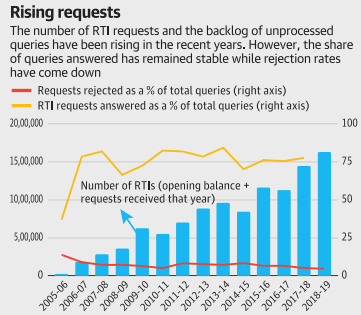
ENVIRONMENT
Pollution fight: painting roads, lasers among options
Painting roads with photocatalytic coating to clean air, using anti-smog guns at construction sites to reduce dust pollution and setting up of a 20 metre-high ‘smog tower’ with air purifiers are among the pilot projects suggested by a High Level Committee (HLC) to the Supreme Court to control air pollution in Delhi and NCR.
About High Level Committee:
- The Supreme Court has directed to form a High Level Committee (HLC) and look into the feasibility of technologies to control and monitor pollution.
- The HLC has members from the Central Pollution Control Board (CPCB), Delhi Pollution Control Committee (DPCC), and NEERI, professors from IIT-Delhi, IIT-Kanpur and heads of environmental departments of Delhi, Haryana, Punjab and Uttar Pradesh.
About the Steps:
- Painting Roads:
- There are companies that develop photocatalytic paints, which can remove pollutants from the air in the presence of sunlight and ultraviolet (UV) rays.
- Photocatalytic paints contain titanium dioxide [TiO2] that acts as a catalyst when exposed to UV rays and removes atmospheric pollutants.
- There is a risk that nanomaterials may result in the production of other undesirable species such as nitrous acid and formaldehyde, which will have adverse health impacts.
- However, such products have been used by the Dubai municipality in parks and in Mexico.
- Smog Tower:
- The proposal had stated that 65% reduction in pollution could be achieved on an average up to 700 metres from the tower.
- Anti Smog Gun:
- Anti-smog gun is a device that sprays nebulised water droplets into the air through high-pressure propellers, which helps particles to settle down.
- Effective in controlling localised dust during the period of application and more suitable to high dust emission zones such as large construction sites.
- Oxy furnace:
- Oxy furnace uses only oxygen as fuel instead of atmospheric air (which contains nitrogen), thus reducing the production of NOx by about 90% in industries.
- The committee has also recommended the use of chemical methods, including dust suppressants to control air pollution.
- Wireless Sensor Network(WSN):
- Wireless Sensor Network (WSN) technology to monitor air pollution is still in developmental stage and IIT and NEERI are reviewing its performance.
- WSN may be used as an indicative monitoring tool for a few activities like mining, large construction sites, to supplement air quality data and report to regulator for conducting further investigation.
- LiDAR:
- LiDAR or Light Detection and Ranging is a high-end application of LASER-based technology for monitoring pollution.
- This technology may be adopted for vertical monitoring at a few places to track transport of pollutants at higher altitude.
PIB
PM remembers brave soldiers who fought in 1971, on the occasion of Vijay Diwas
About Vijay Diwas:
- Vijay Diwas is celebrated on 16th December every year in India to commemorate the Indian forces’ victory over Pakistan in the 1971 Indo-Pak war, which was played out to liberate Bangladesh.
India among top 10 improvers in EODB; India ranks 63 rd among 190 countries
India’s remarkable jump in World Bank’s Ease of Doing Business Report 2020:
- India ranks 63rd among 190 countries improving by 14 ranks from its rank of 77 in 2019.
- India has improved its rank in 7 out of 10 indicators and has moved closer to international best practices.
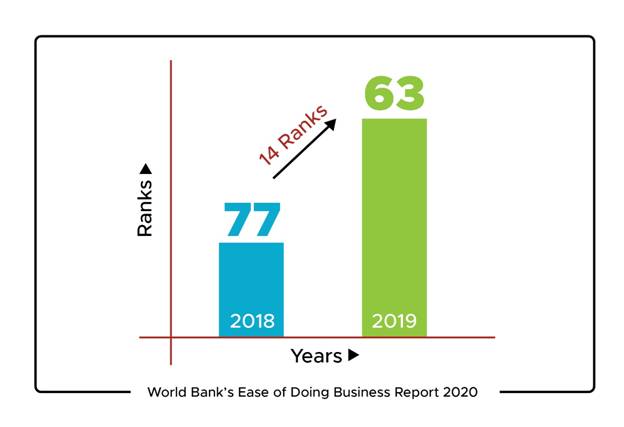
About Ease of Doing Business Report:
- It is published by World Bank.
- This report was introduced in 2003 to provide an assessment of objective measures of business regulations and their enforcement across 190 economies on ten parameters affecting a business through its life cycle.
- 10 parameters used for ranking are- starting a business, construction permits, getting electricity, getting credit, paying taxes, trade across borders, enforcing contracts, and resolving insolvency.
- It ranks countries on the basis of Distance to Frontier (DTF), a score that shows the gap of an economy to the global best practice. For example, a score of 75 means an economy was 25 percentage points away from the frontier constructed from the best performances across all economies and across time.
- Other reports published by World Bank:
- World Development Report
- Global Economic Prospects Report
- Human Capital Index
Start-up India:
21,778 start-ups are now recognised under the Start-up India Initiative, of which 2,912 start-ups have been recognised since 1st June 2019.
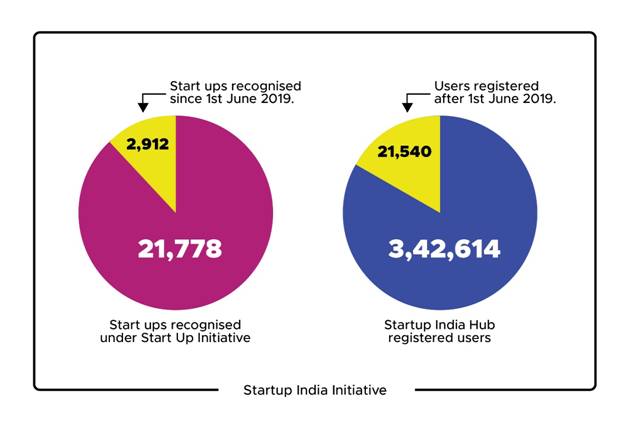
- The Government through this initiative aims to empower start-ups to grow through innovation and design.
- Simple Compliance Regime for start-ups based on Self-certification.
- Launch of Mobile app and portal for compliance and information exchange.
- Faster exit for start-ups
- Providing funding support through a Fund of Funds with a corpus of Rupees 10,000 crore
- Tax exemption on capital gains invested in Fund of Funds
- Tax exemption to start-ups for 3 years
- Organizing Start-up Fests to showcase innovations and providing collaboration platforms
- Annual Incubator Grand Challenge to promote good practices among incubators.
Global Innovation Index (GII):
- In the past 4 years, India’s rank in the GII has improved from 81st rank in 2015 to the present 52nd rank in the GII 2019 report.
- India became the first developing country to launch the Global Innovation Index (GII) in association with the World Intellectual Property Organisation (WIPO) and the Confederation of Indian Industry (CII).
- This is the first time that the GII is being launched in an emerging economy.
- It is published annually by Cornell University, INSEAD and the UN World Intellectual Property Organization (WIPO).
- The theme of GII- 2019 (12th edition) is “Creating Healthy Lives - The Future of Medical Innovation”, which aims to explore the role of medical innovation as it shapes the future of healthcare.
- The GII relies on two sub-indices :
- Innovation Input Sub-Index.
- Innovation Output Sub-Index.
- Input pillars capture elements of the national economy that enable innovative activities:
- Institutions
- Human capital and research
- Infrastructure
- Market sophistication
- Business sophistication.
- Output pillars capture actual evidence of innovation outputs:
- Knowledge and technology outputs
- Creative outputs.
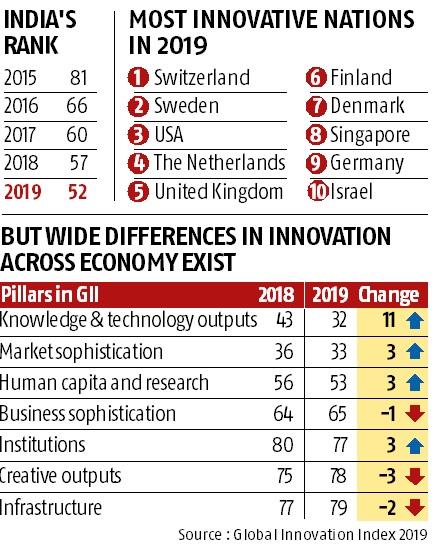
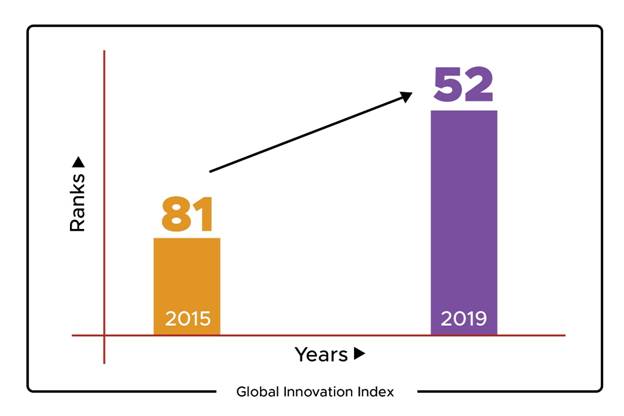
Measures to Promote innovation:
- Final Patent (Amendment) Rules, 2019: This amendment to the Patents Rules, 2003 has led to significant simplification of rules, especially for start-ups and MSMEs.
- National IPR Policy.
Measures to improve exports:
- NIRVIK: A new export credit insurance scheme ‘NIRVIK’ has been introduced.
- An online portal for filing applications under ‘Transport and Marketing Assistance (TMA)’ scheme for Specified Agriculture Products has been launched.
- A database has been prepared by the Export Credit Guarantee Corporation (ECGC) for all pending claims and online access on status of claims has been provided.
- The online “Origin Management System” gives single access point for all exporters, for all Free Trade Agreements (FTAs), Preferential Trade Agreements (PTAs) and for all agencies.
- In order to provide extra support to exports to emerging and challenging markets like Africa, CIS, Latin America and Asian countries, fresh capital has been infused into the ECGC.



1.png)
